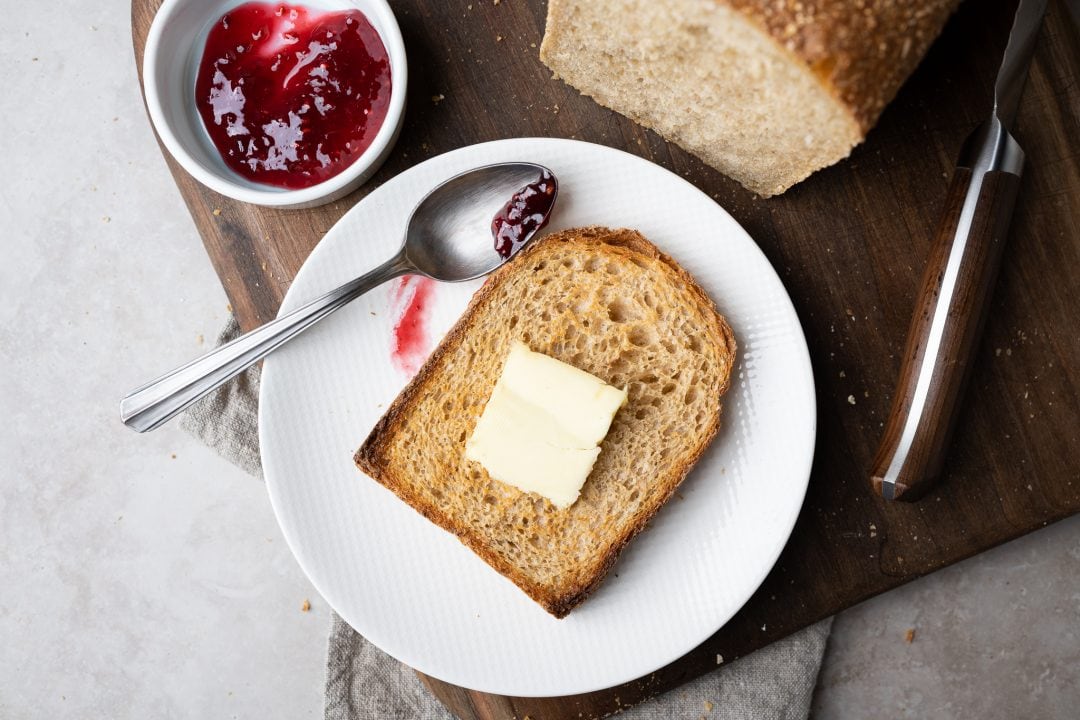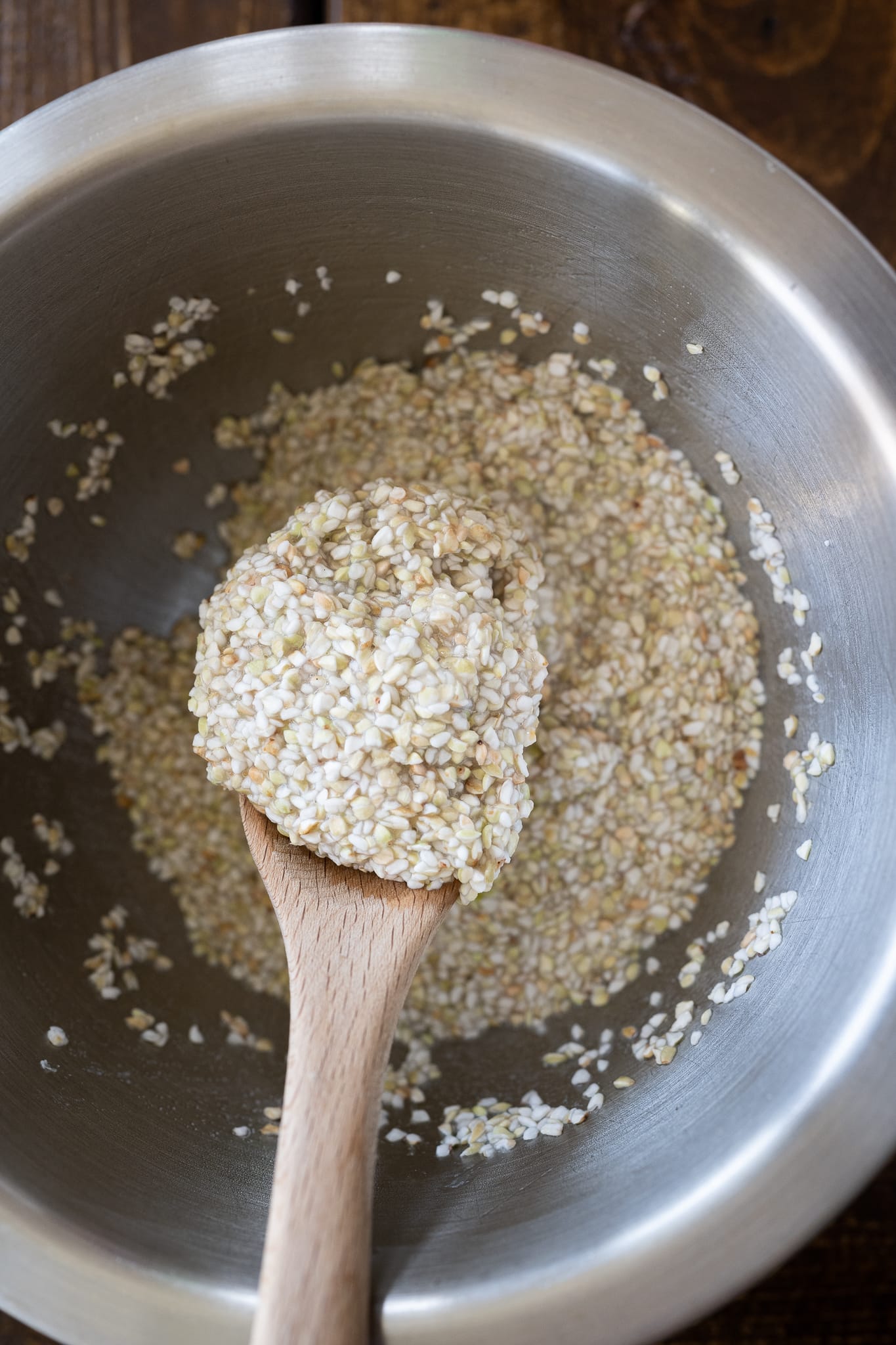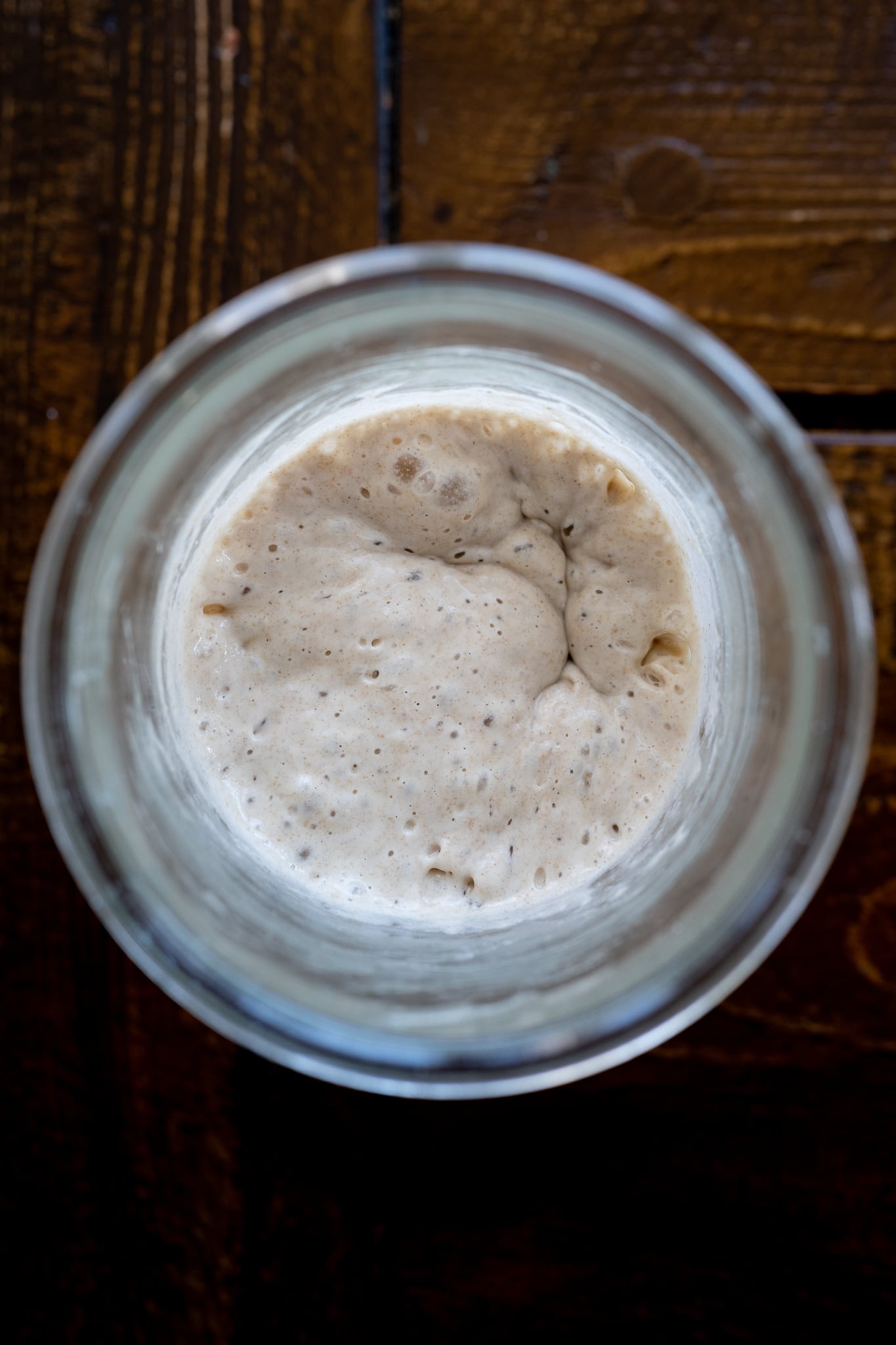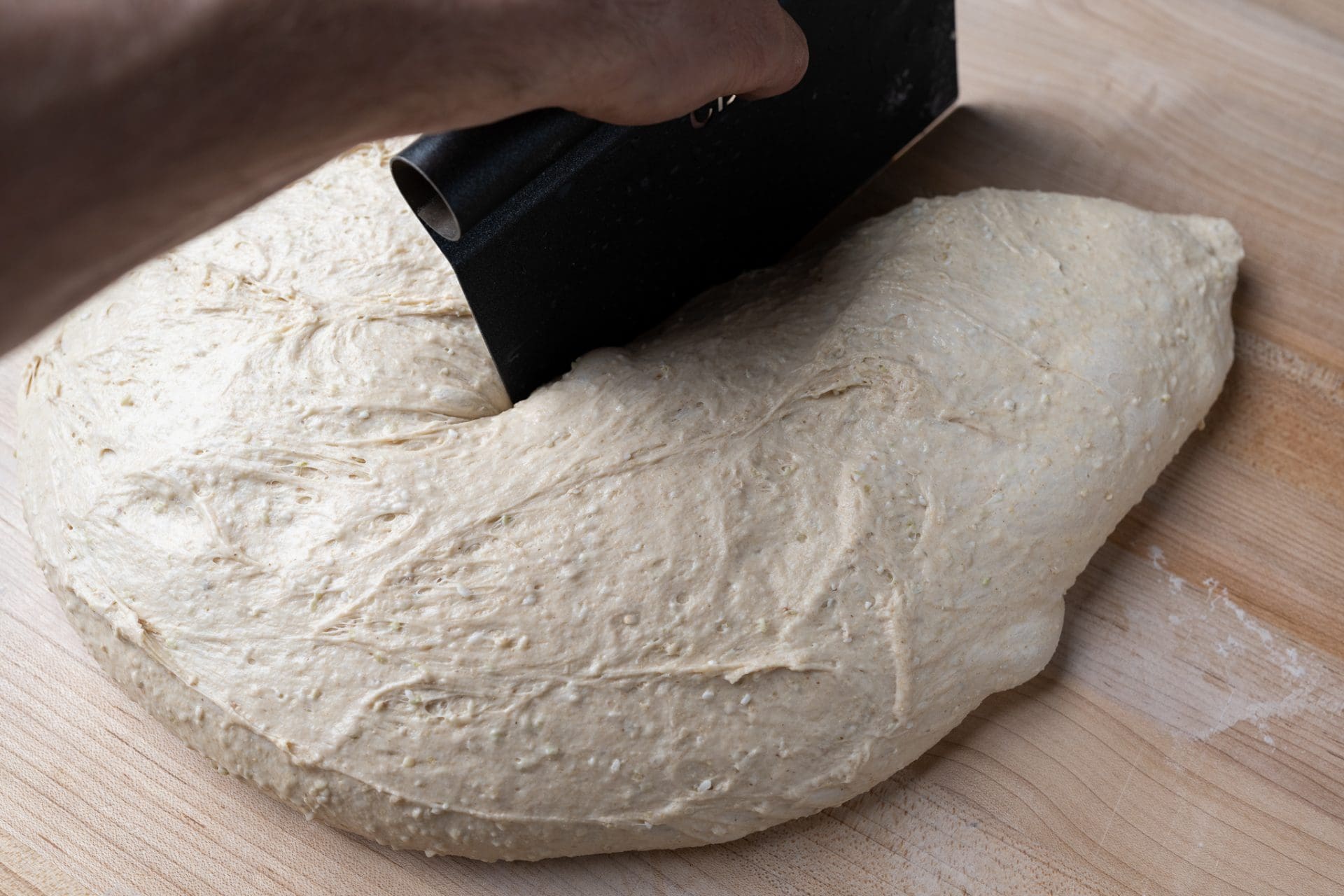I always have a small bag of buckwheat flour in my pantry. It's an easy way to spice up banana bread or waffles, and it tastes wonderful in a loaf of bread, of course. But lately, I've been working with buckwheat in a different capacity: as a cracked soaker of sorts. This soft honey buckwheat sandwich bread calls for a buckwheat porridge which acts similar to a tangzhong or yudane mix-in. When mixed with boiled water, the buckwheat mixture turns into a viscous, creamy paste that exudes a tenderness in the final pan loaf that's hard to beat.
To take the nutrition of this bread a step further, I paired the buckwheat with freshly milled whole white wheat. A flour that, especially when freshly milled, has a lovely aroma and mellow flavor that colors the crumb a creamy hue as golden as the grain itself. Overall, the flavor of buckwheat isn't terribly pronounced in this bread, but you can certainly feel the elements all playing a nutritious role in the final performance.
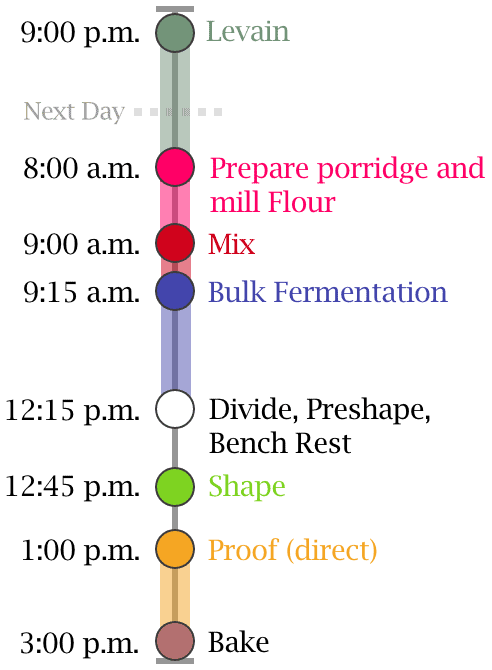
Baking schedule
As shown on the right, this honey buckwheat sandwich bread is made over the course of one day (aside from the overnight levain) but it could be pushed to two. To bake over the course of two days, after shaping and placing the dough in the pans, cover them and cold-proof the dough overnight in the refrigerator. Then, bake the dough in the morning or early afternoon, whichever is more convenient.
Buckwheat porridge
What is buckwheat?
Despite the misnomer, gluten-free buckwheat isn't wheat at all. In fact, unlike wheat, it's not grass; buckwheat is a pseudocereal and more closely related to rhubarb than wheat. Buckwheat is high in protein, fiber, B vitamins, and minerals—all the things we want to try and sneak into our diets in increasing quantity. For me, it's a great way to add nutrition to bread, and I know my kids will enjoy the flavor.
Recommended reading: Read my guide on the best way to store flour, and other things, including buckwheat.
Making the buckwheat porridge
This honey buckwheat sandwich bread has a portion of cracked and then soaked buckwheat mixed into the dough. I use Bob's Red Mill Organic Buckwheat Cereal which is stone-ground buckwheat groats, the consistency somewhere near steel-cut oats. The little bits of buckwheat are perfect because they soften easily when soaked in boiled water and present themselves in the final loaf as small, tender specs. Of course, if you have whole buckwheat groats and a grain mill, you could also crack your own! I found this cracked buckwheat “cereal” at my local market in the breakfast aisle, or you can find it at the link above.
To make the porridge, weigh out the called for cracked buckwheat into a bowl and pour boiled water over the top (the exact weights are listed in the recipe below). Mix so everything gets wet, and let the mixture rest until called for at the end of mixing. If you forget to make this porridge early, stick the bowl in the freezer to rapidly chill the mixture and avoid mixing a hot porridge into your dough (throwing off your final dough temperature).
Flour selection
White wheat shouldn't be confused with white flour, where the latter can be made from hard red wheat, hard white wheat, or a combination. White wheat is a variety of wheat that tends to have a more mild flavor, and in this bread with 40% white wheat, the overall flavor of this bread is mild with a touch of sweetness. White wheat is one of my go-to flour choices when pushing the whole grain percentage when desiring a mild-flavored loaf.
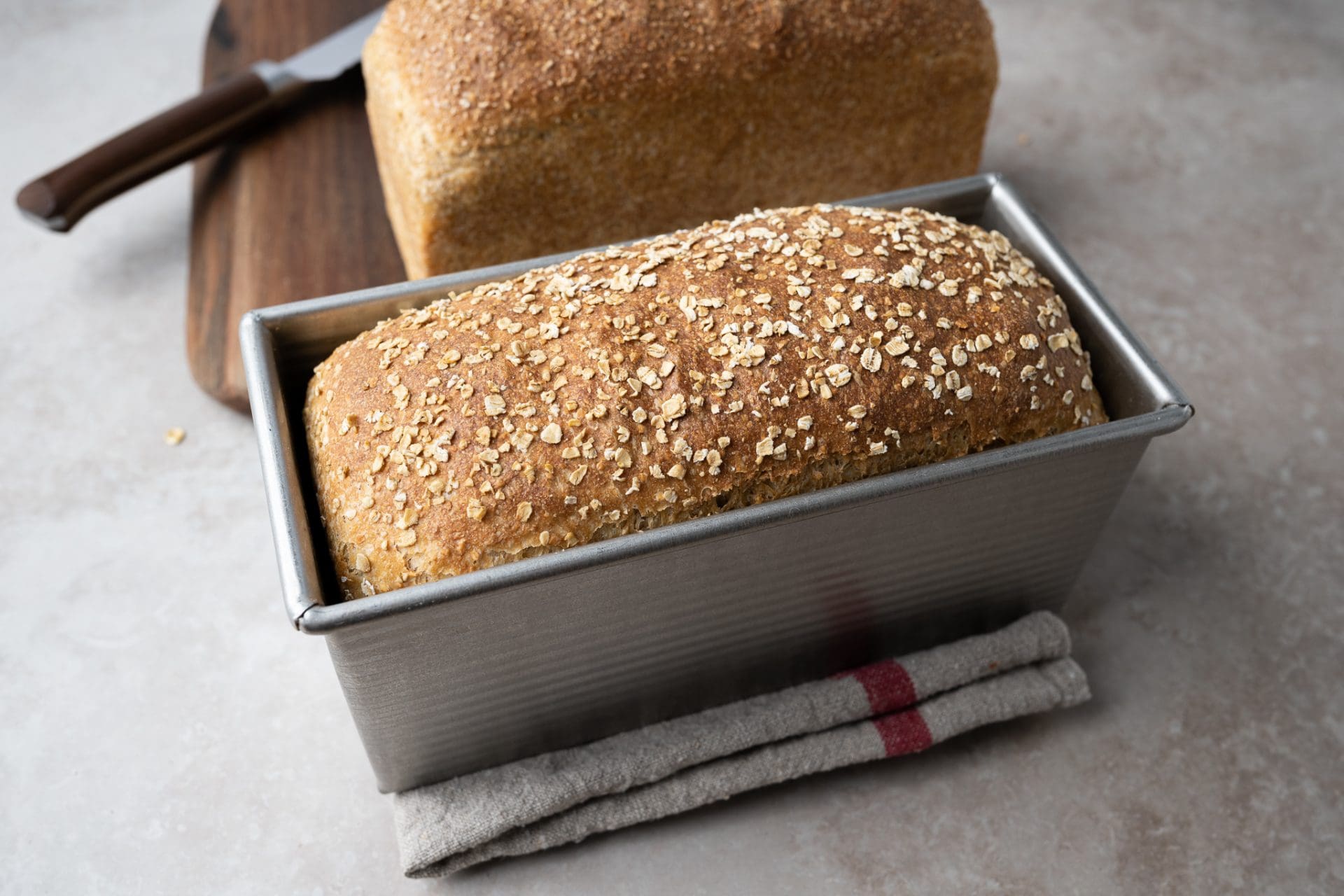
Honey buckwheat sandwich bread formula
Vitals
| Total Dough Weight | 1,800 grams |
| Hydration | 82% |
| Pre-fermented Flour | 7.00% |
| Levain in final dough | 15.81% |
| Yield | Two loaves, each in a 9x4x4 Pullman pan. |
I used two 9x4x4-inch Pullman pans for these loaves without the lids. The interior of these pans has a natural nonstick interior, but I still prefer to butter the pans to ensure the easy removal of the bread after baking.
Total formula
The total formula lists all the ingredients required to make this honey buckwheat sandwich bread. Read on for the method where the ingredients are called for in each of the steps of the bread baking process.
Desired dough temperature: 75°F (23°C). This dough temperature is significantly cooler than my typical 78°F (25°C); I find when using a moderate percentage of freshly milled flour, the lower temperature helps rein in fermentation to more manageable levels. In addition, the added buckwheat porridge brings additional fermentation activity to this dough. Check out my guide to dough temperatures for more information.
| Weight | Ingredient | Baker’s Percentage |
|---|---|---|
| 522g | Medium-protein bread flour or All-purpose flour (~11% protein, Central Milling Artisan Baker’s Craft or King Arthur Baking All-Purpose) | 60.00% |
| 348g | Freshly milled whole white wheat (Hard white wheat) | 40.00% |
| 130g | Cracked buckwheat groats (Bob's Red Mill Creamy Buckwheat Hot Cereal) | 15.00% |
| 35g | Honey (or barley malt syrup) | 4.00% |
| 30g | Neutral flavored oil (vegetable oil)4 | 3.50% |
| 670g | Water 1 (porridge, levain, and early mixing) | 77.00% |
| 43g | Water 2 (later mixing and porridge incorporation) | 5.00% |
| 16g | Fine sea salt | 1.80% |
| 6g | Ripe sourdough starter5 | 0.70% |
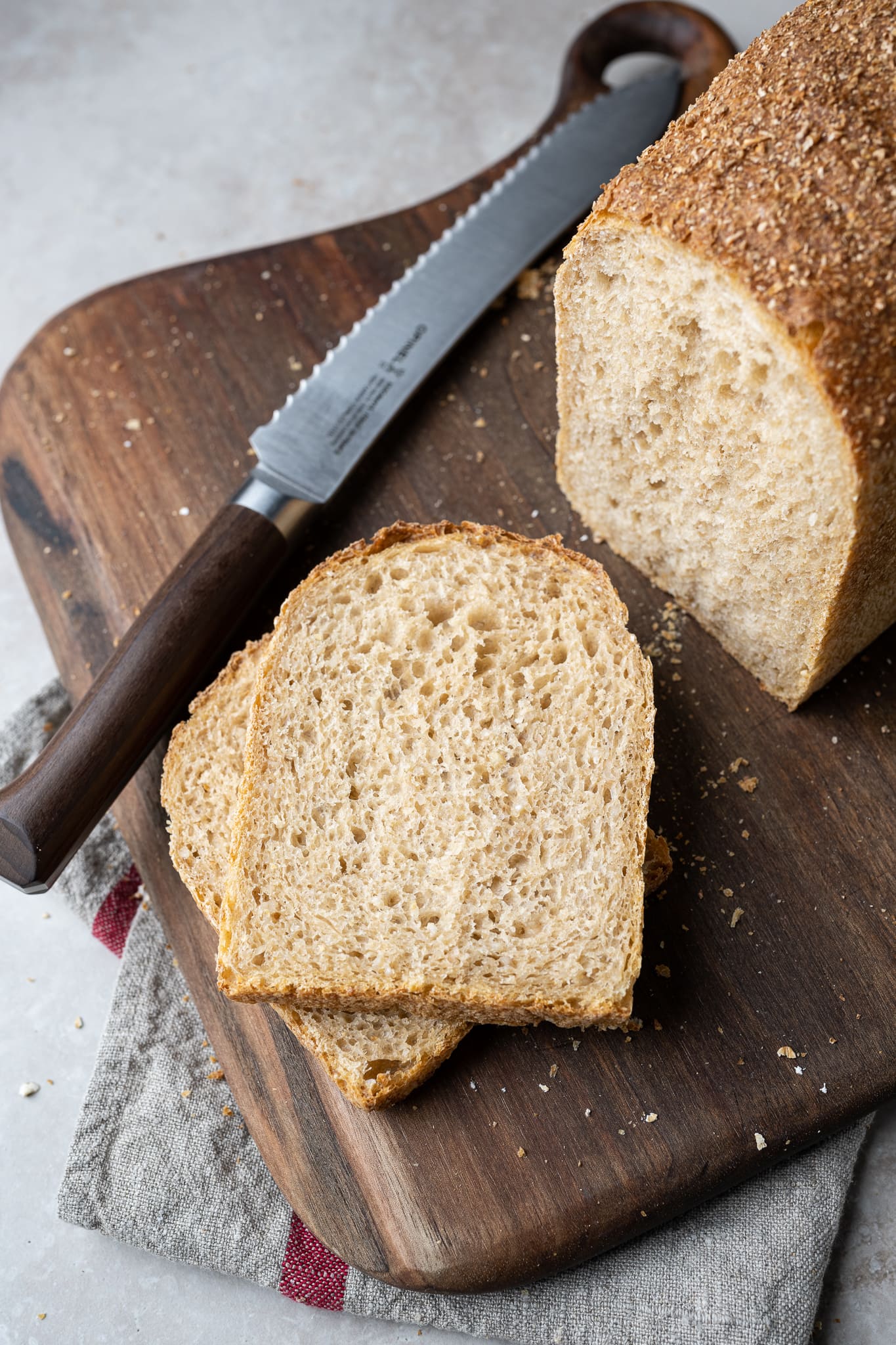
Honey buckwheat sandwich bread method
1. Prepare the levain – 9:00 p.m., the night before mixing
This is a slow, overnight levain. Mix the following ingredients in a container and leave covered to ripen at room temperature, about 76°F (24°C), overnight.
At this time, you can mill a small amount of the total white wheat called for in this recipe to satisfy just the levain, or you can mill the entire amount called for, cover the flour, and use it in the morning. Alternatively, you could use any whole grain flour you have in your pantry for this portion of the flour to make things easier.
Note: This levain uses a tiny portion of ripe sourdough starter to seed the levain, but the levain will expand to fill the preferment requirement. Additionally, I've built in a small buffer to this levain. This means the levain will be a little larger than needed for this recipe to cover any loss (bits left on the side of the jar, spatula, etc.) when making.
| Weight | Ingredient | Baker’s Percentage |
|---|---|---|
| 47g | Medium-protein bread flour or all-purpose flour | 70.00% |
| 22g | Freshly milled whole white wheat flour (or any whole wheat flour in your pantry) | 30.00% |
| 65g | Water 1 | 100.00% |
| 10g | Ripe sourdough starter | 10.00% |
2. Prepare porridge and mill flour — 8:00 a.m., the day of mixing
Set your grain mill to the finest setting and mill 330g white wheat. I used my Mockmill 100 to mill this flour. Once you've milled the flour, set it aside as all of it will be added to the main mix, later.
In a completely separate heat-resistant bowl, place 130g of cracked buckwheat (just the buckwheat, nothing else). Pour 157g boiled water6 over the buckwheat and stir to combine. Set the porridge aside until mixing.
3. Mix – 9:00 a.m.
Your overnight levain should look nice and ripe (see image at side). It will have a sour aroma, be bubbly on top and at the sides, have risen to some degree (with perhaps some collapse), and generally, be a much looser consistency than when you mixed it the night before.
Gather the following ingredients for mixing.
| Weight | Ingredient |
|---|---|
| 479g | Medium-protein bread flour or all-purpose flour |
| 330g | Freshly milled whole white wheat flour |
| 35g | Honey (or barley malt syrup) |
| 30g | Neutral oil |
| 287g | Buckwheat porridge (from step 2) |
| 452g | Water 1 |
| 43g | Water 2 (held back until the second half of mixing) |
| 16g | Fine sea salt |
| 128g | Ripe levain (from step 1, you might have some excess) |
I used my KitchenAid mixer to mix this dough, but you could mix by hand just as well. To the bowl of a stand mixer fitted with the dough hook attachment, add the flour, ripe levain, honey, oil, Water 1, and salt. Turn on the mixer to low and mix until all the ingredients are incorporated, about 2-3 minutes. Depending on your flour, you might need to add additional water to help the ingredients come together, but be conservative with these additions.
Then, turn the mixer up to speed 2 and mix for 2-3 more minutes until the dough strengthens and smooths. Finally, turn the mixer off and let the dough rest for 10 minutes.
After the 10 minute rest, add a small portion of the porridge with a splash of Water 2 and mix at low speed for a minute. Continue to add the rest of the porridge in small increments while the mixer runs, adding a splash of water as needed. Once all the porridge is added, mix until the dough is homogenous. This could take up to 3-4 minutes.
The dough will feel strong and cohesive at the end of mixing but won't be completely smooth or fully developed. Transfer the dough to a container for bulk fermentation and cover.
4. Bulk fermentation – 9:15 a.m. to 12:15 p.m.
At a warm room temperature, around 74-76°F (23-24°C), bulk should take about 3 hours. This dough needs two sets of gentle stretches and folds during bulk fermentation at 30-minute intervals (the first set starts 30 minutes after the beginning of bulk fermentation). If, after the last set, the dough still feels very slack and weak, add in a third set as necessary.
5. Divide and preshape – 12:15 p.m.
At the end of bulk fermentation the dough will have risen significantly but not be overly wet or loose. As you can see below, the dough is showing signs of significant fermentation: healthy rise, some bubbles, a doming of the edge of the dough near the bowl—it's ready to be divided.

Fill a bowl with some water and place it on your work surface. Scrape out your dough from the bulk container onto your dry counter. Divide the mass in half using a bench knife. Using a wet hand and the knife in the other, gently preshape each half into a loose round.
Let the preshaped dough rest, uncovered, for 30 minutes until it's relaxed outward.
6. Shape – 12:45 p.m.
First, I like to butter the interior of my baking pan. The USA Pan Pullman pans have a natural nonstick coating on them, but I like to butter them lightly to ensure the loaves remove cleanly after baking.
Next, optionally spread a thin layer of raw wheat bran, rolled oats, or even white sesame seeds, on a clean kitchen towel, plate, or baking sheet, and place it on your work surface. After you shape your dough, you'll roll the smooth side of the dough on this thin layer of toppings to coat the exterior.
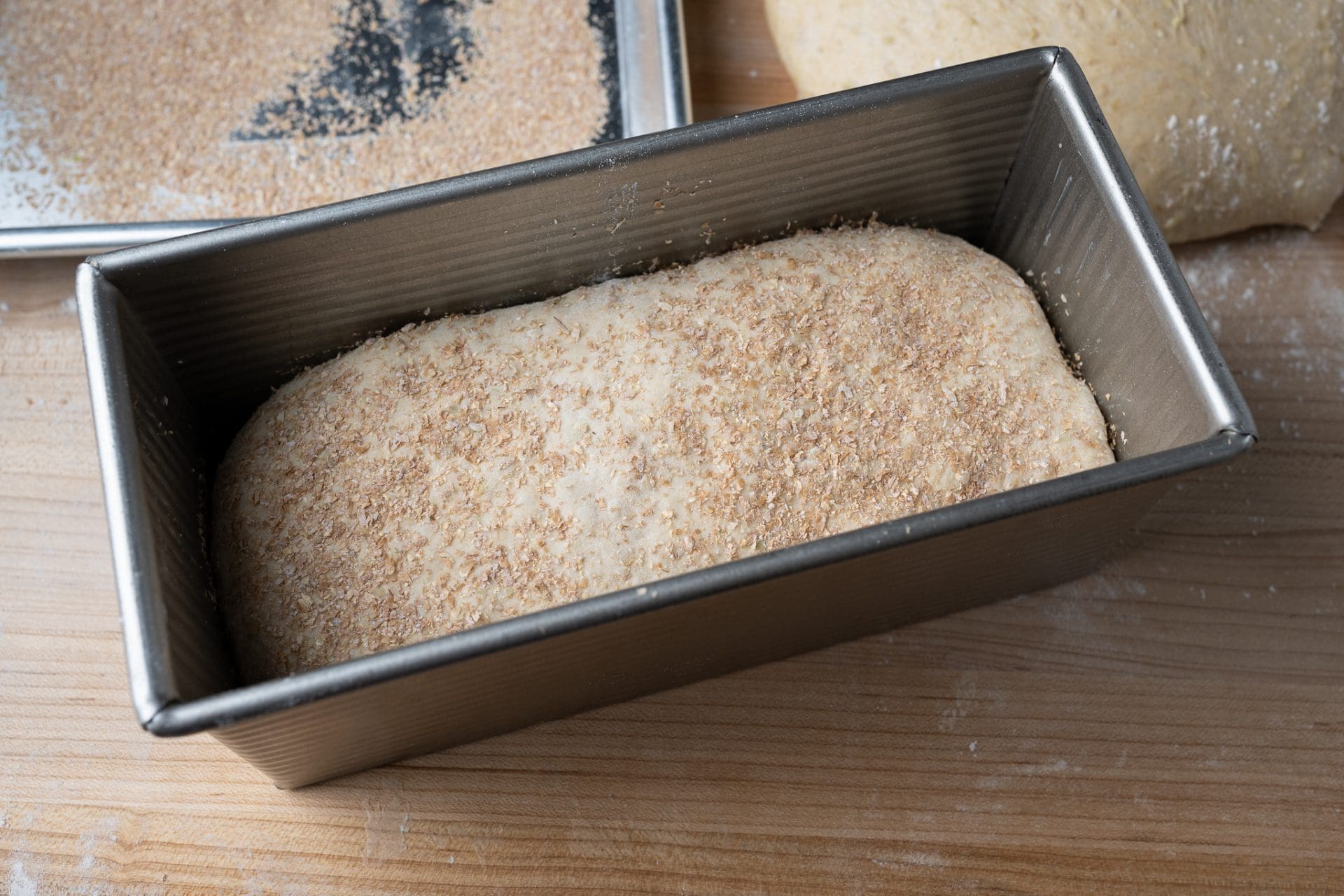
Recommended reading: Check out my guide to shaping pan loaves for an in-depth explanation and video to help with shaping this dough.
7. Proof – 1:00 p.m. to 3:00 p.m.
Cover the two Pullman pans with a single large, reusable proofing bag and seal it shut. Let the dough proof on the counter for about two hours until very puffy, and an indentation with the finger hardly springs back.
Watch the dough in the last 30 minutes of this proof time as it can quickly over proof if warm in your kitchen. Be sure to preheat your oven a little early before the dough is fully proofed so it's ready for baking.
8. Bake – 3:00 p.m.
Preheat your empty oven with a rack in the middle to 425°F (220°C). For these loaves, I steamed my oven following my guide on steaming a home oven for bread baking. I wanted to get as much steam in the oven as possible, so I used both the pan with rolled-up towels and the pan with lava rocks.
When your dough is ready, uncover the Pullman pans and slide them into the oven—bake for 20 minutes with steam. Then, remove the steaming pans from inside the oven, turn the oven down to 375°F (190°C), and bake for an additional 35 minutes, or until the crust is deeply colored and the interior temperature registers around 200°F (93°C).
Once fully baked, be sure to cool your loaves on a cooling rack for 1-2 hours before slicing—which is very important with these pan loaves. Also, see my post on the best way to store bread to keep it fresh for a week or longer.

I've been testing this soft honey buckwheat sandwich bread for weeks. The combination of freshly milled flour and buckwheat porridge made for such a soft bread that it's become somewhat of a breakfast favorite around here lately. I've even used it to make wonderful BLT sandwiches that go down all too easy. But, of course, one of the joys of baking your own sourdough bread is the simple fact that you can have healthy bread on your cutting board made from only a small handful of healful ingredients—not sure it gets any better than that.
Buon appetito!
Print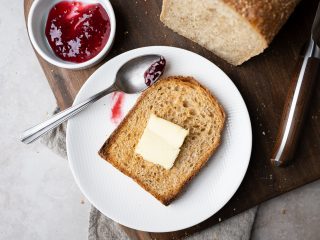
Honey buckwheat sandwich bread recipe
- Author: Maurizio Leo
- Prep Time: 24 hours
- Cook Time: 1 hour
- Total Time: 25 hours
- Yield: 2 loaves
- Category: Bread, Sandwich
- Cuisine: American
Description
An extremely soft sandwich bread made with a touch of honey, freshly milled white wheat, and a cooked buckwheat porridge. The porridge brings a level of tenderness to this bread similar to adding in tangzhong.
Ingredients
Levain
- 47g medium-protein bread flour or all-purpose flour
- 22g freshly milled whole white wheat flour
- 65g water
- 10g ripe sourdough starter
Porridge
- 132g cracked buckwheat groats (I used Bob's Red Mill buckwheat cereal)
- 158g boiled water
Main dough
- 479g medium-protein bread flour or all-purpose flour
- 330g freshly milled whole white wheat
- 35g honey (or barley malt syrup)
- 30g neutral-flavored oil (vegetable oil)
- 287g buckwheat porridge (from step 2)
- 452g water 1 (levain, porridge, mix)
- 43g water 2 (later mixing)
- 16g fine sea salt
- 128g ripe levain (from step 1)
Optional topper
- Raw wheat bran, rolled oats, or white sesame seeds
Instructions
- Levain (9:00 p.m., night before mixing)
In a small bowl, mix and knead the Levain ingredients. Transfer to a small container, cover, and keep it at a warm temperature for 5 hours. - Prepare porridge and mill flour (8:00 a.m.)
Finely mill 330g of white wheat flour. In a heat-resistant bowl, add the porridge ingredients and mix. Set the flour and porridge aside to cool until mixing. - Mix (9:00 a.m.)
To the bowl of a stand mixer fitted with the dough hook attachment, add the flour, ripe levain, honey, oil, Water 1, and salt. Turn on the mixer to low and mix until all the ingredients are incorporated, about 2-3 minutes. Depending on your flour, you might need to add additional water to help the ingredients come together, but be conservative with these additions. Then, turn the mixer up to speed 2 and mix for 2-3 more minutes until the dough strengthens and smooths. Finally, turn the mixer off and let the dough rest for 10 minutes. After the 10 minute rest, add a small portion of the porridge with a splash of Water 2 and mix at low speed for a minute. Continue to add the rest of the porridge in small increments while the mixer runs, adding a splash of water as needed. Once all the porridge is added, mix until the dough is homogenous. This could take up to 3-4 minutes. - Bulk Fermentation (9:15 a.m. to 12:15 p.m.)
This dough needs 2 sets of stretches and folds during bulk fermentation, where the first set starts after 30 minutes into bulk fermentation, and the subsequent sets are at 30-minute intervals. After the second set of stretches and folds, let the dough rest, covered, for the remainder of bulk fermentation. - Divide and Preshape (12:15 p.m.)
Scrape the dough out from your bulk fermentation container to your work surface. Using wet hands, divide the dough in half. Lightly shape each half into a round shape. Let the dough rest for 30 minutes, uncovered. - Shape (12:45 p.m.)
Butter two 9x4x4″ Pullman pans. Shape each round of dough into a long tube to fit each pan. If desired, roll each piece of dough in any of the Optional Toppers, then place the dough, seam side down, in the Pullman pan. - Proof (1:00 p.m. to 3:00 p.m.)
Cover the pans with reusable plastic and seal shut. Then, let the dough proof on the counter until well-risen and very soft to the touch. - Bake (3:00 p.m.)
Preheat your empty oven with a rack in the middle to 425°F (220°C). When your dough is ready, uncover the Pullman pans and slide them into the oven—bake for 20 minutes with steam. Then, remove the steaming pans from inside the oven, turn the oven down to 375°F (190°C), and bake for an additional 35 minutes, or until the crust is deeply colored and the interior temperature registers around 200°F (93°C). Once fully baked, be sure to cool your loaves on a cooling rack for 1-2 hours before slicing.
Notes
- If you don't have white whole wheat, a red wheat variety will also work well for this recipe.
- If you're using aged whole wheat flour in place of the freshly milled white wheat, expect that your dough might take longer in bulk fermentation and/or proof.
What's next?
If you're looking for more recipes with buckwheat—especially buckwheat flour—check out my sourdough bread with dried cherries, pecans, and buckwheat.
You could use olive oil, but the flavor might sneak through a little at the end (not necessarily the worst thing!).↩
This is a small amount of starter, but it will be used to make a larger preferment (levain).↩
This water is taken from Water 1.↩
You could use olive oil, but the flavor might sneak through a little at the end (not necessarily the worst thing!).↩
This is a small amount of starter, but it will be used to make a larger preferment (levain).↩
This water is taken from Water 1.↩


